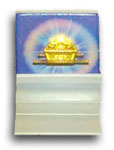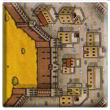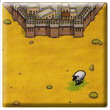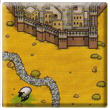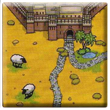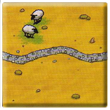The Ark of the Covenant Base Game
Joshua has led the children of Israel into the Promised Land and you have been given the unique responsibility to help develop the area by building roads, cities, temples and raising sheep. Deploy a Prophet into the cities to preach repentance. Take on the sacred duty of moving The Ark of the Covenant around to different areas of the Land.
General Info and Comments
The Ark of the Covenant was originally released in 2003 [1].
Based on the 2001 Game of the Year: Carcassonne [2].
A Clever Tile-Laying Game for 2-5 Players Ages 8 and up, by Klaus-Jürgen Wrede.[3]
![]() Question: Can anyone state whether the game is generic Christian, or has certain specific features that are specialised to certain segments of Christianity?
Question: Can anyone state whether the game is generic Christian, or has certain specific features that are specialised to certain segments of Christianity?
Answer: The game teaches no doctrine – it is based on an Old Testament theme, and has common Old Testament references like prophets and temples, but that’s the extent of the doctrine. It should be non-offensive for anyone, regardless of their religious beliefs.
Contents
- 72 Land Tiles (including one starting tile with a different coloured back) which picture city, road and field segments and temples
- 40 Followers in 5 colours - one of each player's followers is used as the player's scoring marker
- 5 Prophets – Extra-large followers [4], one of each colour
- 1 Ark of the Covenant [5]
- 1 Scoring Track, used to track the player's scores
- Rule Booklet
Overview
Players take turns placing land tiles on the table. [6] As they do so, the roads, cities, fields and temples emerge and expand. On these tiles, the players can place their followers to earn points. Players can also score points by moving The Ark of the Covenant throughout the land past their followers. After the final scoring round, the player with the most points is the winner. [7]
Preparation
Place the starting tile face up in the middle of the table. Shuffle the remaining tiles face down and stack them in several face-down stacks so that all players have easy access to them. Place the scoring track off to the side, leaving room to place land tiles in the middle of the table. [8]
Each player takes the 8 followers and 1 Prophet in his colour and places one follower as his scoring marker on the starting space of the scoring track. Each player places his remaining pieces before him on the table as his supply. The player who last read a portion of the Bible will be the starting player. [9]
Playing the Game
Players take turns in a clockwise order, beginning with the starting player. On a player's turn, he performs the following actions in the order shown: [10]
1. The player must draw a new land tile and place it on the table.
2. The player now chooses one of the following actions:
- a) Place one of his followers from his supply to the land tile he just placed or the Prophet from his supply to a city portion of that land tile (if applicable)
- or
- b) Instead of placing a follower or Prophet, the player may move The Ark of the Covenant across 1 to 5 tiles on the board.
- or
- c) The player may elect to take no action.
3. If, by placing the land tile, roads, cities or temples are completed, they are now scored.
4. The next player’s turn now begins.
Placing Land Tiles
To place a land tile, a player must draw a land tile from one of the face-down stacks.
- The new tile (shown with red borders in the examples) must be placed with at least one edge touching one previously placed tile. Tiles cannot be placed so that they only touch diagonally. [11]
- The new tile must be placed so that all field, city and road segments on the new tile continue any field, city and road segments on the tile or tiles that it is touching.
In the rare circumstance where a drawn tile has no legal placement (and all players agree), the player discards the tile from the game into the box and draws another tile to play.
Placing Followers
After a player places a land tile, they may place one of their followers on that tile, [12] using these simple rules:
- The player may only place 1 follower on a turn.
- The player must take it from his supply.
- The player may only place the follower on the tile that he just played.
- The player must choose where to deploy the follower on the tile. A follower may be placed on a city, road or field segment. A follower may not be placed directly on a temple.[13][14]
- -OR-
- The player may choose to deploy his Prophet instead of a follower (see next section for details).
- The player may not deploy a follower on a field,[15] city or road segment if that segment connects to a segment on different tile (no matter how far away) that already has a follower (from any player) on it.
When a player has deployed all his followers, he continues to play land tiles on each turn. [16] Although followers may not be taken off of the tiles once they are placed, followers are returned to players when temples, roads and cities are scored.
Placing Prophets
Sometimes, the people in the cities become wicked and need to repent. God has always called Prophets to preach repentance to His people.
During the game, you may use your Prophet one time in a city. Instead of placing a follower in a city segment, you would place your Prophet. [17] When the city is completed, you score double the amount of points for that city. Your Prophet is then removed from the game and placed into the box. All normal placement rules for followers apply to the Prophets.[18]
Moving the Ark of the Covenant
The Ark of the Covenant is placed on the board immediately when the first city is completed.
The player who completed that city, decides on which tile of the city he wishes to place The Ark. He places The Ark on one of the completed city segments and his turn is now over. [19]
![]() Question: What exactly happens when you place the Ark? The rules states that as soon as the first city is completed, the Ark is placed on one of the tiles of the completed city and that person’s turn is now over. The game rules state that the sequence of a turn is:
Question: What exactly happens when you place the Ark? The rules states that as soon as the first city is completed, the Ark is placed on one of the tiles of the completed city and that person’s turn is now over. The game rules state that the sequence of a turn is:
1) Draw a tile and place it
2) Do one of the following:
a) place a follower/prophet
b) move the Ark (if present)
c) do nothing
3) if the tile completed the city, road, or temple, score it
4) end of turn.
So where does the Ark fit in? When the first city is completed, may you place a follower in addition to placing the Ark? When the Ark is placed, does the first closed city score points?
Answer: The Ark is not placed until a city is completed, which happens at step 3. Therefore, someone could place a tile closing the city, play a meeple [follower], then see that the city is complete, score it, and then place the Ark.
Now that The Ark is on the playing surface you have the option, after you have played a tile, of placing a follower, moving The Ark, or taking no action. If you decide to move The Ark, you can move it from 1 to 5 tile spaces.
![]() Question: Can The Ark of the Covenant be moved only orthogonally [horizontally or vertically], or may it be moved diagonally?
Question: Can The Ark of the Covenant be moved only orthogonally [horizontally or vertically], or may it be moved diagonally?
Answer: Only orthogonally.
You may not move it onto a tile that you have already moved across on your turn (you can not backtrack [20]). The Ark may not end its trek on the same tile from which it started. [18][21] For each follower that you pass with The Ark, that player receives 1 point. [22]
![]() Question: Do you score points when The Ark is moved on or through a tile with your Prophet? The rules explicitly state "follower" and I could be persuaded either way.
Question: Do you score points when The Ark is moved on or through a tile with your Prophet? The rules explicitly state "follower" and I could be persuaded either way.
Answer: Yes, you would receive one point if you move it past a Prophet.
Note: If The Ark starts on a tile which includes a follower, that follower does not score 1 point when The Ark begins its journey. If The Ark ends on a tile with a follower, that follower scores 1 point.
Scoring Completed Roads, Cities and Temples
If a road, city or temple is "completed" by the placement of the land tile, it is now scored.
Completed Road
A road is complete when the road segments on both ends connect to a crossing, a city segment or a temple, or when the road forms a complete loop.
There may be many road segments between the ends. The player who has a follower on a completed road scores 1 point for each tile in the road (count the number of tiles only; separate segments on the same tile count just once) and 1 point for each oasis.
The player moves his scoring marker forward on the scoring track the number of spaces equal to the points earned. If you pass 50 on the scoring track, lay your scoring marker face down to indicate a score greater than 50 and continue along the track.
Completed City
A city is completed when the city is completely surrounded by a city wall and all the spaces within the city are filled with tiles. [23] There may be many city segments in a completed city.
The player who has a follower in a completed city scores two points for each tile in the city (count the number of tiles only; separate segments on the same tile count just once).
Each scroll in a completed city earns 2 additional points.
What Happens When a Completed City or Road Has More Than One Follower?
It is possible, through clever placement of land tiles, for there to be more than one follower on a road or city. When this occurs in a completed road or city, the player with the most followers on a road or in a city receives all the points.
When two or more players tie with the most followers, they each receive the total points for the road or city.
Note: Prophets only act as 1 follower when determining who controls a city for scoring purposes. If red has 1 follower and blue has 1 Prophet in a city, then both players would score but blue would receive double the points for having the Prophet in the city.
Completed Temple
A temple is completed when it has tiles on the left, right, top and bottom of the temple tile in the form of a cross. [24][25]
First, check to see if any roads or cities are scored by the placement of the last tile around the temple and score those first - removing any followers that are on those roads or cities. [26] Then, the player with the most followers on those adjacent cross-tiles or on the Temple tile itself, scores 7 points. [27][28]
If two or more players tie for the most followers, than those players all receive the 7 points. All followers and Prophets surrounding the temple stay in place until the roads, cities and fields that they are on, are scored. [18]
Note: Sometimes it is smart to try to finish opponent's roads around temples in order to remove their followers from around the temple tile!
Returning Followers to Player’s Supplies
After a road or a city is scored (and only then), the followers involved are returned to the appropriate player's supplies. The returned followers may be used again by the players in later turns. Prophets are used only once and then are returned back to the box and not to the player’s supply. [18]
Note: It is possible for a player to deploy a follower, score a road or a city, and have the follower returned on the same turn (always in the order shown):
- Complete a road or city area by placing the new tile.
- Deploy a follower.
- Score the completed road or city.
- Return the follower to your stock.
The Fields
Connected field segments are where your followers herd sheep.
Fields are bordered by roads, cities and the edges of the area where the land tiles have been played. [29]
When you place a follower in a field, that follower remains in the field, watching over the flocks, until the end of the game and are never returned to the player's stock.
Game End
At the end of the player's turn in which the last land tile is placed, the game ends. Final scoring then takes place.
Final Scoring
First, for each incomplete temple, the player or players with the majority of followers on the temple tile and on the four surrounding tiles (right, left, up and down) score 3 points. After you score the temples, leave the followers in place as they may still be scored for incomplete roads and cities as well as fields.
Second, all incomplete roads and cities are scored. For each incomplete road and city, the player who has a follower on a road or followers/Prophets in a city, earns one point for each road or city tile. [30] Scrolls in the cities, as well as oases on the roads, are also worth 1 point each.
For incomplete roads and cities which include more than one follower, use the rules for completed roads and cities to determine who scores.
Note: To make scoring easier, after scoring an incomplete road or city, remove the corresponding follower off the board.
Scoring Fields
The followers in the fields are now scored.
- Count how many sheep and wolves are in the field. For each wolf in a field, a sheep is eaten by the wolf and that sheep is not scored. [31]
- The remaining sheep in your field are worth 2 points each.
- If multiple players have followers in a single field area, only the player with the most followers scores.
- If there is a tie for control of a field, then both players receive the points.
![]() Question: Can you score negative points if there are more wolves than sheep in a field?
Question: Can you score negative points if there are more wolves than sheep in a field?
Answer: You cannot go negative.
The player with the most points at the end of the final scoring is the winner!
Tips
- When you place followers in the fields, place them lying down so that all players can easily see which fields they are in. [32]
- Don't underestimate the usefulness of moving The Ark. If you can't score any points by placing a follower or if you have limited followers, go for the easy points by moving The Ark past your followers.
- After your turn has passed, immediately grab a new tile so that you can be looking at where you will play when your turn comes up again. This dramatically speeds up play time.
Tile Distribution
72 tiles: The tile outlined in red is the Start Tile.
Footnotes
For Icons explanation and licensing please visit Icons page.
- ↑ The first edition English rules (2003) were developed by Jeremy Young, Matt Molen and Guido Teuber. This development team were joined for the second edition release (2005) by Rick Thornquist and Greg Aleknevicus.
- ↑ Carcassonne by Klaus-Jürgen Wrede is published by Hans im Glück (European edition) and Rio Grande Games (American English edition) Ed: RGG was the English publisher in 2008, when the CAR was produced. Since that time the English version of Carcassonne has also been published by Z-Man Games.
- ↑
 The first edition read: 'A Clever Tile-Laying Game for 2-5 Players aged 10 and above'
The first edition read: 'A Clever Tile-Laying Game for 2-5 Players aged 10 and above'
- ↑ Do not get confused between the Prophet (extra large follower) and a follower. The Prophet can only be deployed in a city, and then only once. After a player has scored with it the Prophet is removed from the game.
- ↑ In the first edition a cardboard ark token and plastic stand was provided. In the second edition, the cardboard Ark was upgraded to a wooden Ark, the picture also being changed for that edition.
- ↑
 The first edition read: 'The players place land tiles turn by turn on to the table.'
The first edition read: 'The players place land tiles turn by turn on to the table.'
- ↑
 The first edition read: 'The player with the most points, after the final scoring round, is the winner.'
The first edition read: 'The player with the most points, after the final scoring round, is the winner.'
- ↑
 The first edition read: 'Place the scoring track near one edge of the table to leave room for the players to place land tiles in the middle of the table.'
The first edition read: 'Place the scoring track near one edge of the table to leave room for the players to place land tiles in the middle of the table.'
- ↑ Due to the market that The Ark of the Covenant was aimed at, this rule is not surprising. Should you find that no player has read the Bible then the players should decide amongst themselves as to which player will start the game. However, why not read a portion of the Bible, so you are ready for your next game?
- ↑
 The sequence in the first edition read:
The sequence in the first edition read:
1. The player must draw a new land tile and place it on the table.
2. The player may place one of his followers from his supply to the land tile he just placed or the Prophet from his supply to a city portion of that land tile (if applicable).
-OR-
3. Instead of placing a follower or Prophet, the player may move The Ark of the Covenant across 1 to 5 tiles on the board.
4. If, by placing the land tile, roads, cities or temples are completed, they are now scored.
5. The next player’s turn now begins. - ↑
 The first edition read: ‘Tiles cannot be placed diagonally.’
The first edition read: ‘Tiles cannot be placed diagonally.’
- ↑ You can only deploy followers to city, road and field segments. You cannot deploy a follower directly to the Temple feature itself.
- ↑
 The first edition read: ‘The player must choose where to deploy the follower on the tile.'
The first edition read: ‘The player must choose where to deploy the follower on the tile.'
- ↑
 The German edition, Die Baumeister des Königs (Diehl Medien, 2004), allows a follower to be placed directly on a Temple, but only states this in the section on Temple Completion, not in this section.
The German edition, Die Baumeister des Königs (Diehl Medien, 2004), allows a follower to be placed directly on a Temple, but only states this in the section on Temple Completion, not in this section.
- ↑ The pictured examples show a follower deployed in a field as lying down. See ‘Tips’ section for details.
- ↑
 The first edition read: ‘When a player has deployed all his followers, he continues to play land tiles each turn.’
The first edition read: ‘When a player has deployed all his followers, he continues to play land tiles each turn.’
- ↑
 The first edition read: 'Instead of placing a follower in a city segment, you would instead place your Prophet.'
The first edition read: 'Instead of placing a follower in a city segment, you would instead place your Prophet.'
- ↑ Jump up to: 18.0 18.1 18.2 18.3
 The previous sentence was added in the second edition.
The previous sentence was added in the second edition.
- ↑
 The German edition, Die Baumeister des Königs, gives the player who places the Ark into the first city a bonus of 2 points.
The German edition, Die Baumeister des Königs, gives the player who places the Ark into the first city a bonus of 2 points.
- ↑ From the pictured example, one might think that the Ark must only move in a straight line. However, the Ark can move orthogonally (horizontally and vertically). The Ark must not return to a tile that has already been occupied during its 5 tile movement, which is what is meant by the word ‘backtrack’.
- ↑
 In the German edition, Die Baumeister des Königs, the Ark can only move after the first Temple is drawn and laid, and then it only moves in a direct route towards the Temple.
In the German edition, Die Baumeister des Königs, the Ark can only move after the first Temple is drawn and laid, and then it only moves in a direct route towards the Temple.
- ↑
 In the German edition, Die Baumeister des Königs, if the Ark reaches the Temple, the player who moved the Ark receives a bonus of 3 points.
In the German edition, Die Baumeister des Königs, if the Ark reaches the Temple, the player who moved the Ark receives a bonus of 3 points.
- ↑
 The first edition read: 'A city is completed when the city is completely surrounded by a city wall and there are no open gaps in the wall.'
The first edition read: 'A city is completed when the city is completely surrounded by a city wall and there are no open gaps in the wall.'
- ↑
 The pictured example in the first edition contained an impossible situation with a RED and GREEN farmer on adjacent tiles in the same field. The second edition of the rules changed the example to show a legal placement of followers/Prophets.
The pictured example in the first edition contained an impossible situation with a RED and GREEN farmer on adjacent tiles in the same field. The second edition of the rules changed the example to show a legal placement of followers/Prophets.
- ↑
 In the German edition, Die Baumeister des Königs (Diehl Mieden, 2004) it is in this section that it states, "Wer die Tempelkarte anlegt, kann seinen Gefolgsmann direkt auf den Tempel oder auf die Straßen und Weiden der Karte setzen." which translates as "If you place the temple tile, you can place your follower directly on the temple or on the roads and pastures of the tile".
In the German edition, Die Baumeister des Königs (Diehl Mieden, 2004) it is in this section that it states, "Wer die Tempelkarte anlegt, kann seinen Gefolgsmann direkt auf den Tempel oder auf die Straßen und Weiden der Karte setzen." which translates as "If you place the temple tile, you can place your follower directly on the temple or on the roads and pastures of the tile".
- ↑
 The first edition read: 'First, check to see if any roads are scored by the placement of the last tile around the temple and score those first - removing any followers that are on those roads.'
The first edition read: 'First, check to see if any roads are scored by the placement of the last tile around the temple and score those first - removing any followers that are on those roads.'
- ↑ Some players use four markers (or meeples of a neutral colour) to show which Temple has been scored and which has yet to score. This is because it can get confusing as to which Temples have been scored, due to the fact that followers remain in play on the board after Temple scoring has occurred.
- ↑
 In the German edition, Die Baumeister des Königs, if the Ark is on a temple tile when that temple is completed the score of 7 points is doubled, therefore, the player who has the majority scores 14 points.
In the German edition, Die Baumeister des Königs, if the Ark is on a temple tile when that temple is completed the score of 7 points is doubled, therefore, the player who has the majority scores 14 points.
- ↑
 In the first edition, this paragraph came after the next one.
In the first edition, this paragraph came after the next one.
- ↑
 The first edition read: 'For each incomplete road and city, the player who has a follower on a road or in a city, earns one point for each road or city segment.'
The first edition read: 'For each incomplete road and city, the player who has a follower on a road or in a city, earns one point for each road or city segment.'
- ↑
 The first edition read: 'Count how many sheep and wolves are in the field. Each wolf eats one sheep!'
The first edition read: 'Count how many sheep and wolves are in the field. Each wolf eats one sheep!'
- ↑ Followers deployed in fields are shown in the graphics throughout this guide as lying down. They are not shown as such in the official rules.







